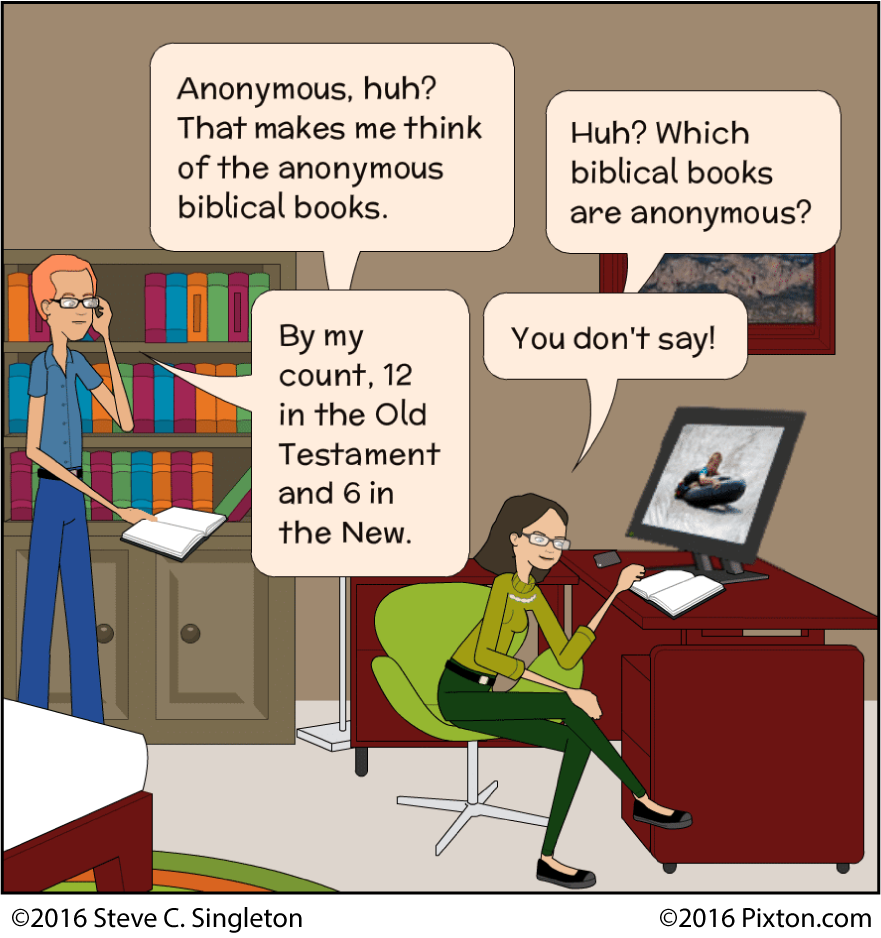The anonymous books of the Bible: another tool for deeper study
Anonymous: 18 out of 66
The usual procedure for studying a biblical text is to begin with who wrote it and under what circumstances. If the author has chosen to be anonymous, however, this procedure becomes impossible. When we examine closely the books of the Bible, we discover that 12 of the 39 Old Testament books are anonymous: Genesis, Judges, Ruth, 1 and 2 Samuel, 1 and 2 Kings, 1 and 2 Chronicles, Esther, Job, and Ecclesiastes. Of the 27 New Testament books, six are anonymous: Matthew, Mark, Luke, John, Acts, and Hebrews. Let’s look closer at each one of these 18 books.
Anonymous books of the Old Testament
Genesis
Although Genesis is called the First Book of Moses, nowhere in Genesis, or in the rest of the Pentateuch for that matter, is there any hint about who wrote it. Higher critics from the 19th century onward have repudiated this claim of Mosaic authorship. They asserted that Genesis is a compilation of at least two written sources, distinguished by the use of two divine names in various portions of the document. As the years progressed, the analysis became more and more detailed, and scholars competed with one another, proposing ever more elaborate and contradictory theories.
More recently, however, some scholars have recognized that much of the repetition, variation, and diversity in Genesis can be attributed to the highly sophisticated literary artistry of one author, a style very alien to the rationalistic higher critics of the 19th and 20th centuries. Mosaic authorship of Genesis, in other words, has made a come-back in recent times.
The content of Genesis 1 and 2 seems consistent with the need Moses would have had to explain origins to the Israelites just coming out of Egyptian bondage. The fundamental message of the Creation Account has five components: 1) all of world history is linear rather than cyclical, with a chronological beginning; 2) the one true God is the creator of the universe and everything in it; 3) nothing in all of creation is a competing god or deserving of worship; 4) every created thing was made to be good; and 5) human beings are the pinnacle of the creation activity—they function as God’s agents to manage his world. Each of these components seems intended to counteract pagan accounts of creation.
The rest of Genesis serves to answer questions the children of Israel would have had as they emerged from their 400-year exile from Canaan. What is their relationship with the other nations? Why are there so many different languages? What is the history of our people? How did our 12 tribes arise? How did we end up in Egypt?
Genesis also provides an historical and theological foundation for the Mosaic covenant. For example, virtually every one of the 10 Commandments finds a historical precedent somewhere in Genesis. Why have no other gods? Because God alone is the creator of everything. Why avoid making graven images? Because God has created his own image in human beings., and so on.
Also, the continuity between Genesis and Exodus is strong evidence that both have the same author.
This is not necessarily to deny, however, that Moses may have used written sources in the writing of Genesis. One theory about sources compatible with Mosaic authorship is the idea that Genesis is comprised of a succession of family histories, each brought up to date by the patriarch of that generation. Each successive recorder appends a colophon at the end of his part of the record. This colophon consists of the phrase, “These are the generations [or ‘history’] of…” adding his name (see Genesis 2:4; 5:1; 6:9; 10:1; 11:10, 27; 25:12, 19; 36:1, 9; 37:2). Moses himself may have added the Joseph narrative.
In a few scattered verses of Genesis, we find notes that seem to be from a time later than Moses (e.g., Genesis 14:2, 3, 7, 8, 15, 17; 16:14; 23:2; 35:19). We know that ancient scribes often added marginal notes to texts explaining obscure references. Rather than serving as evidence that the entire book was written later than Moses, the need for such updates bears witness to the antiquity of the main text.
Judges
Between a carefully constructed prologue and epilogue, the content of the main part of the Book of Judges records the triumphs and tragedies of seven champions of the various tribes of Israel. The main theme of the book concerns the gracious patience of God in the face of the unfaithfulness of his people.
We do not find in Judges any assertion regarding authorship. The statement that twice occurs, “in those days Israel had no king; everyone did as they saw fit” (Judges 17:6; 21:25) and twice more with only the first clause (Judges 18:1; 19:1) seems to suggest that the date of writing was some time after the establishment of the kingship. An alternate explanation, less likely, is that the author was implying that Israel was so rebellious that she did not acknowledge God as her king.
According to rabbinic tradition, Samuel was the author of Judges. Yet Samuel died only shortly after anointing the first king. His stormy relationship with King Saul suggests that he may not have seen the first king’s reign as much of an improvement over the time of the judges.
Ruth
The author of the Book of Ruth nowhere reveals himself. The brief genealogy that closes the book (see Ruth 4:18-22) suggests an author at the time of King David. Rabbinic tradition names Samuel as the author, but this seems unlikely, because Samuel died before David ascended the throne. The prophet Nathan is another possible author.
Samuel, Kings, and Chronicles
Each of these three books—Samuel, Kings, and Chronicles—was originally one scroll, divided at a convenient spot when translated into Greek. Samuel gives the history of the first two kings, Saul and David. A possible author is mentioned in 2 Samuel 8:17: Seraiah, David’s secretary, but we do not know for sure.
The book of Kings actually names three of its sources: the “Book of the Acts of Solomon” (1 Kings 11:41), the “Book of the Chronicles of the Kings of Israel” (1 Kings 14:19; 15:31; 16:5, 14, 20, 27; 22:39; 2 Kings 1:18; 10:34; 13:8, 12; 14:15, 28; 15:11, 15, 21, 26, 31), and the “Book of the Chronicles of the Kings of Judah” (1 Kings 14:29; 15:7, 23; 22:45; 2 Kings 8:23; 12:19; 14:18; 15:6, 36; 20:20; 21:17, 25; 23:28; 24:5).
Other sources are possible, including the narratives involving Elijah, Elisha, and Ahab, as well as the portion that recurs in the Book of Isaiah (2 Kings 18:13 – 20:19), but the text does not identify these or any others.
The book of Kings ends shortly after the destruction of Jerusalem by the Babylonians. Its purpose seems to be to teach the people that the Babylonian captivity was the climactic punishment for a series of rebellions against the Lord. The implication is that they needed to repent in order to experience the return from exile.
If the ancient rabbis are correct that Ezra is the author of Chronicles, he wrote it about 100 years later than Kings. The close connection between the end of 2 Chronicles and the beginning of Ezra seems to confirm this attribution (compare 2 Chronicles 36:22-23 with Ezra 1:1-3).
The purpose of Chronicles seems to contrast with that of Kings. It is not a call to repentance but presents a message of hope to people languishing in despair because of the exile. Chronicles also has an emphasis on the Temple and its priests and Levites that is missing in Kings. This suggests an additional purpose of inspiring the people to focus on the restored Temple and its worship.
Esther
Esther is another book that does not identify its author. The most likely candidate is Mordecai, the kinsman of the Jewish queen of Persia. If this is true, why would Mordecai, so obviously devoted to God, fail to mention the name of God even once in his book? One possible answer is that Mordecai was afraid the Persians would appropriate the Book of Esther and substitute the name of one of their gods in place of the Lord. In a clever yet subtle way, the author of Esther has talked about God without calling him by name.
Job
We can find no indication in the Book of Job who wrote it. The ancient rabbis attributed to Moses perhaps because he wrote of the patriarchal times in his Book of Genesis. Yet this cosmic drama focused on whether God is good is so unlike the known writings of Moses!
Ecclesiastes
Although Solomon is the traditional author of Ecclesiastes, certain details within the book seem to argue against Solomonic authorship. For example, the author uses the phrase, “anyone who has ruled over Jerusalem before me” (Ecclesiastes 1:16), but this would not be appropriate for Solomon; his father David was the only preceding King, unless we count the Jebusite kings of the city-state of Salem.
Some would defend Solomonic authorship by pointing out that the phrase “greater by far than anyone in Jerusalem before me” (Ecclesiastes 2:9) would only be appropriate for Solomon. We must grant, however, that this phrase might be an example of hyperbole, a common figure of speech in the Hebrew Bible. Furthermore, the author’s declaration, “I was king over Israel in Jerusalem” (Ecclesiastes 1:12) may suggest that at the time of writing he was an ex-king. This would certainly not fit Solomon, who reigned until his death.
Only two kings, however, ruled over Israel from Jerusalem: David and Solomon. Shortly after the death of Solomon, the kingdom divided into the northern nation of Israel with its capital in some area in the southern nation of Judah, whose capital continue to be Jerusalem. It may be, however, that some kings of Judah continued to call their kingdom Israel, a custom that the prophets sometimes confirm (see Isaiah 5:7 and Jeremiah’s habit of calling the Lord “the God of Israel,” e.g., Jeremiah 31:23, even though his prophetic ministry was exclusively devoted to Judah).
There is no simple solution to these difficulties, and the authorship of Ecclesiastes must remain unresolved.
Anonymous books of the New Testament
Matthew and Mark
Though tradition has ascribed names for the authors of the First and Second Gospels, the books themselves leave almost no clues as to their identity. Those looking for ways to substantiate the traditional attributions have pointed out that Matthew’s many references to money and to counting would be appropriate for the gospel of a former tax collector. They also remark that the story of the young man fleeing naked into the night at the time of Jesus’ arrest (Mark 14:51-52) may be Mark’s autobiographical and self-deprecating mini-sketch.
It is perhaps more helpful to point out that Matthew is the most Jewish of the Four Gospels, with a definite emphasis on fulfilled the messianic prophecies and that Mark seems to reflect a Roman point of view, with its emphasis on action and quick changes of scene. Early church fathers held that Mark made notes of the Apostle Peter’s preaching, and published them as a gospel account. Perhaps, then, the Second Gospel would be more appropriately entitled the Gospel of Peter.
Luke and Acts
The Third Gospel and its sequel, the Acts of the Apostles, is also anonymous but both books are addressed to the man named “Theophilus” (Luke 1:3; Acts 1:1). In addition, the Book of Acts has two sections in which the author includes himself in the action by using the first person plural pronouns (see Acts 16:10-17; 20:6-end). From these “we sections” we may be confident that the author of Luke-Acts was a close companion of the Apostle Paul, and Luke fills the bill quite handsomely (see Colossians 4:14 and 2 Timothy 4:11). Because in Colossians Paul calls Luke “the beloved physician,” one 19th-century attempt to confirm Luke and authorship examined the medical language in Luke-Acts.
John
The author of the Fourth Gospel identifies himself as “the disciple whom Jesus loved” and bears testimony as an eyewitness of the death of Christ (John 19:35). Other autobiographical passages point to John the son of Zebedee as the author (see John 1:35-42; John 19:26-27; John 20:2-9; and John 21:1-24). This seems to be confirmed by the similarity of style and vocabulary between the Fourth Gospel and the epistles of John.
Hebrews
Despite the Authorized Version’s title at the head of the book of Hebrews, “The Epistle of St. Paul to the Hebrews,” authorship of this New Testament epistle has been disputed since ancient times. Some have said it comes from Paul’s hand, but others point to the differences between Hebrews and the Paul’s epistles. For example, the introductory formulae that Hebrews uses when quoting from the Old Testament are varied but distinct from Paul’s typical phrase, “It is written.” The reasoning seems different from Paul’s, as well as which psalms the author identifies as messianic.
Through the centuries other authors have been proposed, including Apollos, Barnabas, Luke, Clement of Rome, and even Priscilla, but none has garnered a consensus among scholars. The famous saying of Origen will probably remain true: “Only God knows who wrote Hebrews.”
The Author we do know about
Although the anonymity of these biblical authors may be a stumbling block to some, yet the children of Israel and the disciples of Jesus have long recognized that their writings bear the marks of inspiration. The divine Author of these works as well as the rest of the books of the Bible has left evidence of his work as the world’s best communicator of divine truth.
As the Apostle Paul writes, “all Scripture is God-breathed and is useful for teaching, rebuking, correcting, and training in righteousness, so that the man of God may be thoroughly he quipped for every good work” (2 Timothy 3:16-17).
Want to go deeper?
Recommended for further reading…
David A. Dorsey. The literary structure of the Old Testament: a commentary on Genesis – Malachi. Grand Rapids, Mich.: Baker, 1999.
By demonstrating the literary structure of each of the 39 books of the Old Testament, Dorsey makes a major contribution toward confirming the literary integrity of each document. In book after book, Dorsey finds what he calls symmetry in the organization of the text. Other scholars have called the same structure chiastic, noting a reverse parallelism between the beginning and the end, the next section and the next to the end, and so forth. This leads to a climactic middle section which bears the emphasis of the structure. Many Old Testament writings and even some of the New Testament documents seem to have chiastic structure.
Roland K. Harrison. Introduction to the Old Testament with a comprehensive review of Old Testament studies and a special supplement on the Apocrypha. Grand Rapids, Mich.: Eerdmans, 1969.
Harrison provides an excellent discussion of the introductory details of all Old Testament books while maintaining a conservative though thoroughly informed viewpoint.



